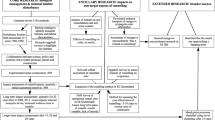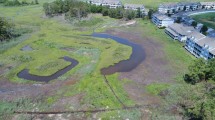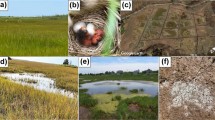Abstract
Runnelling is a minor and successful form of open marsh water management developed in Australia in the 1980s and integrated into mosquito control programs in the 1990s. While long-term monitoring and investigation of impacts has continued for one site, until recently there has been no assessment of operational runnelling more broadly across mosquito control agencies. This study addresses this issue. Forty-seven runnelled saltmarsh sites were assessed for runnel efficacy, function and condition. Issues impacting on runnel function, including both ecological and geomorphic processes, were noted. Data were mostly acquired from site inspections and discussions with mosquito control staff, with some records as available. Most runnels were constructed between 1990 and 2005, mainly using a dedicated runnelling machine. Almost half (49%) continued to contribute to mosquito control efficacy, either in part or fully, while half did not (51%). Efficacy was attributed to runnels being correctly configured in design, layout and construction and to relatively recent maintenance. Conversely, diminished efficacy was mostly attributed to ineffective hydrologic function, caused by vegetation blockages, erosion and/or deposition. Runnels alter tidal hydrology, affecting other ecological and geomorphic processes. These processes need to be managed to maintain runnel function and it is essential that monitoring and maintenance records are kept. Runnels can control mosquitoes for decades, provided ongoing monitoring and maintenance of the runnel system focusses on responding to early signs of impacts. Restoring degraded runnels should be undertaken using a runnel machine, however, changing environmental conditions may mean that a runnel should be ‘decommissioned’ instead.







source and fringing mangroves encroaching onto marsh in the distance (Photo taken by JK)
Similar content being viewed by others
Data availability
The datasets generated during and/or analysed during the current study are available from the corresponding author on reasonable request.
References
Alsemgeest GP, Dale PER, Alsemgeest DH (2005) Evaluating the risk of potential acid sulfate soils and habitat modification for mosquito control (runneling) in coastal salt marshes: comparing methods and managing the risk. Environ Manage 36:152–161. https://doi.org/10.1007/s00267-003-0112-4
Berg JA et al (2010) Mosquito control and wetlands. Wetl Sci Pract 27:24–34
Breitfuss M (2003) The effects of physical habitat modification for mosquito control, runnelling, on selected non-target saltmarsh resources. Doctoral Thesis, Griffith University
Breitfuss MJ, Connolly RM, Dale PER (2003) Mangrove distribution and mosquito control: transport of Avicennia marina propagules by mosquito-control runnels in southeast Queensland saltmarshes. Estuar Coast Shelf Sci 56:573–579. https://doi.org/10.1016/S0272-7714(02)00207-X
Breitfuss MJ, Connolly RM, Dale PER (2004) Densities and aperture sizes of burrows constructed by Helograpsus haswellianus (Decapoda: Varunidae) in saltmarshes with and without mosquito-control runnels. Wetlands 24:14–22. https://doi.org/10.1672/0277-5212(2004)024[0014:DAASOB]2.0.CO;2
Breitfuss M, Chapman H, Dale P, Thomas P (2006) Influence of saltmarsh habitat modification for mosquito control on shore crab populations in southeast Queensland. Wetlands (Australia) 22:1–10
Brooks H et al (2021) Resistance of salt marsh substrates to near-instantaneous hydrodynamic forcing. Earth Surf Process Landf 46:67–88. https://doi.org/10.1002/esp.4912
Carlson DB (2006) Source reduction in Florida’s salt marshes: management to reducce pesticide use and enhance the resource. J Am Mosq Control 22:534–537. https://doi.org/10.2987/8756-971X(2006)22[534:SRIFSM]2.0.CO;2
Chapman H, Dale P, Kay B (1998) A method for assessing the effects of runneling on salt marsh grapsid crab populations. J Am Mosq Control 14:61–68
Connolly RM (2005) Modification of saltmarsh for mosquito control in Australia alters habitat use by nekton. Wetl Ecol Manage 13:149–161. https://doi.org/10.1007/s11273-004-9569-z
Dale PER (2008) Assessing impacts of habitat modification on a subtropical salt marsh: 20 Years of monitoring. Wetl Ecol Manage 16:77–87. https://doi.org/10.1007/s11273-007-9058-2
Dale P, Knight J (2006) Managing salt marshes for mosquito control: impacts of runnelling, open marsh water management and grid-ditching in sub-tropical Australia. Wetl Ecol Manag 14:211–220. https://doi.org/10.1007/s11273-005-1113-2
Dale P, Knight J (2012) Managing mosquitoes without destroying wetlands: an eastern Australian approach. Wetl Ecol Manage 20:233–242. https://doi.org/10.1007/s11273-012-9262-6
Dale P, Dale P (2016) Environmental change over 28 years in a subtropical salt marsh: optimal classification and pictures from the exposition. Community Ecol 17:198–204. https://doi.org/10.1556/168.2016.17.2.8
Dale PER, Dale PT, Hulsman K, Kay BH (1993) Runnelling to control salt marsh mosquitoes: long term efficacy and environmental impacts. J Am Mosq Control 9:174–181. https://doi.org/10.1007/s11273-005-1113-2
Dale P, Eslami-Andargoli L, Knight J (2013) The impact of encroachment of mangroves into saltmarshes on saltwater mosquito habitats. J Vector Ecol 38:330–338. https://doi.org/10.1111/j.1948-7134.2013.12048.x
Dale P, Knight J, Daniels P (2018) A simple method and tool to compare mosquito larval control by source reduction and aerial larviciding. J Am Mosq Control. https://doi.org/10.2987/17-6684.1
Dale P, Knight J, Breitfuss M (2021) An Australian form of Open Marsh Water Management (runnelling): long term monitoring, ancillary and extended research. Wetl Ecol Manage. https://doi.org/10.1007/s11273-021-09806-8
Deegan LA, Johnson DS, Warren RS, Peterson BJ, Fleeger JW, Fagherazzi S, Wollheim WM (2012) Coastal eutrophication as a driver of salt marsh loss. Nature 490:388–392. https://doi.org/10.1038/nature11533
Eslami-Andargoli L, Dale P, Sipe N, Chaseling J (2009) Mangrove expansion and rainfall patterns in Moreton Bay, southeast Queensland, Australia. Estuar Coast Shelf Sci 85:292–298
Eslami-Andargoli L, Dale P, Sipe N (2013) Does spatial scale affect the pattern of mangrove change under different rainfall regimes? An example in southeast Queensland, Australia. Aust Ecol 38:208–218. https://doi.org/10.1111/j.1442-9993.2012.02393.x
Eslami-Andergoli L, Dale PER, Knight JM, McCallum H (2015) Approaching tipping points: a focussed review of indicators and relevance to managing intertidal ecosystems. Wetl Ecol Manage 23:791–802. https://doi.org/10.1007/s11273-014-9352-8
Griffin L, Knight J (2012) A review of the role of fish as biological control agents of disease vector mosquitoes in mangrove forests: reducing human health risks while reducing environmental risk. Wetl Ecol Manage 20:243–252. https://doi.org/10.1007/s11273-012-9248-4
Hulsman K, Dale PER, Kay BH (1989) The Runnelling method of habitat modification: an environment focussed tool for salt marsh management. J Am Mosq Control 5:226–234
Jones J, Dale PER, Chandica AL, Breitfuss MJ (2004) Changes in the distribution of the grey mangrove Avicennia marina (Forsk.) using large scale aerial color infrared photographs: are the changes related to habitat modification for mosquito control? Estuar Coast Shelf Sci 61:45–54. https://doi.org/10.1016/j.ecss.2004.04.002
Knight JM (2011) A model of mosquito-mangrove basin ecosystems with implications for management. Ecosystems 14:1382–1395. https://doi.org/10.1007/s10021-011-9487-x
Knight JM, Dale PER, Spencer J, Griffin L (2009) Exploring LiDAR data for mapping the micro-topography and tidal hydro-dynamics of mangrove systems: an example from southeast Queensland, Australia. Estuar Coast Shelf Sci 85:593–600. https://doi.org/10.1016/j.ecss.2009.10.002
Knight J, Griffin L, Dale P, Phinn S (2012) Oviposition and larval habitat preferences of the saltwater mosquito, Aedes vigilax, in a subtropical mangrove forest in Queensland, Australia. J Insect Sci 12(6):1–11. https://doi.org/10.1673/031.012.0601
Knight J, Eslami-Andargoli L, Dale P, Fry B (2017) State changes in tropical intertidal systems: a palaeo-ecological approach. J Coastal Res 33:208–217. https://doi.org/10.2112/jcoastres-d-15-00245.1
Latchford JA (1997) The Effectiveness and Environmental Impacts of Runnelling, a Mosquito Control Technique. Doctoral Thesis, Murdoch University
Latchford JA (1998) The impacts of runnelling on saltmarsh vegetation and substrate. In: McComb AJ, Davis JA (eds) Wetlands for the future. Gleneagles Publishing, Adelaide, pp 327–334
Lesser CR (2007) Open marsh water management: a source reduction technique for mosquito control. Delaware Mosquito Control Section, Delaware Department of Natural Resources and Environmental Control
Maher N, Salazar C, Fournier A (2021) Advancing salt marsh restoration for coastal resilience: a learning exchange. Wetl Ecol Manag. https://doi.org/10.1007/s11273-021-09841-5
Marx SK, Knight JM, Dwyer PG, Child DP, Hotchkis MAC, Zawadzki A (2020) Examining the response of an eastern Australian mangrove forest to changes in hydro-period over the last century. Estuar Coast Shelf Sci 241:106813
Meredith WH, Saviekis DE, Stachecki CJ (1985) Guidelines for “Open mash water management” in Delaware’s salt marshes—objectives, System designs, and installation procedures. Wetlands 5:119–133. https://doi.org/10.1007/BF03160791
Murray AB, Knaapen MAF, Tal M, Kirwan ML (2008) Biomorphodynamics: physical-biological feedbacks that shape landscapes. Water Resour Res. https://doi.org/10.1029/2007wr006410
Ofiara D, Allison J (1986) A comparison of alternative mosquito abatement methods using benefit-cost analysis. J Am Mosq Control 2:522–528
Online Resource 1 MP06-minor-new-works-June2012.
Online Resource 2 MP02-Existing-lawful-structures-2011.
Provost MW (1977) Source reduction in salt-marsh mosquito control: past and future. Mosq News 37:689–698
Rey J et al (2012) North American Wetlands and Mosquito Control. Int J Environ Res Public Health 9:4537–4605. https://doi.org/10.3390/ijerph9124537
Ritchie SA, Addison DS (1992) Oviposition preferences of Aedes taeniorhynchus (Diptera: Culicidae) in Florida mangrove forests. Environ Entomol 21:737–744. https://doi.org/10.1093/ee/21.4.737
Rogers K, Saintilan N, Heijnis H (2005) Mangrove encroachment of salt marsh in Western Port Bay, Victoria: the role of sedimentation, subsidence, and sea level rise. Estuaries 28:551–559. https://doi.org/10.1007/BF02696066
Russell RC, Dwyer DE (2000) Arboviruses associated with human disease in Australia. Microb Infect 2:1693–1704. https://doi.org/10.1016/s1286-4579(00)01324-1
Saffigna P, Dale P (1999) Acid sulfate soils in intertidal mosquito breeding habitats and implications for habitat modification. J Am Mosq Control 15:520–525
Saintilan N, Williams RJ (1999) Mangrove transgression into saltmarsh environments in south-east Australia. Glob Ecol Biogeogr 8:117–124. https://doi.org/10.1046/j.1365-2699.1999.00133.x
Saintilan N, Rogers K, McKee KL (2019) The shifting saltmarsh-mangrove ecotone in Australasia and the Americas. In: Perillo GME, Wolanski E (eds) Coastal wetlands. Elsevier, Amsterdam, pp 915–945
Shisler JK, Harker W (1981) Source reduction as an economical approach to mosquito management. Mosq News 41:419–423
Shisler JK, Schulze TL (1985) Methods for evaluation of costs associated with permanent and temporary control methods for salt-marsh mosquito abatement. J Am Mosq Control 1:164–168
Smith JAM, Pellew M (2021) Pond dynamics yield minimal net loss of vegetation cover across an unditched salt marsh landscape. Estuaries Coast 44:1534–1546. https://doi.org/10.1007/s12237-020-00882-2
Wang C, Temmerman S (2013) Does biogeomorphic feedback lead to abrupt shifts between alternative landscape states? An empirical study on intertidal flats and marshes. J Geophys Res F Earth Surf 118:229–240. https://doi.org/10.1029/2012JF002474
Whitt AA, Coleman R, Lovelock CE, Gillies C, Ierodiaconou D, Liyanapathirana M, Macreadie PI (2020) March of the mangroves: drivers of encroachment into southern temperate saltmarsh. Estuar Coast Shelf Sci 240:106776. https://doi.org/10.1016/j.ecss.2020.106776
Wigand C et al (2017) A climate change adaptation strategy for management of coastal marsh systems. Estuaries Coast 40:682–693. https://doi.org/10.1007/s12237-015-0003-y
Wolfe R, Zarebicki P, Meredith W (2021) The evolution of saltmarsh mosquito control water management practices relative to coastal resiliency in the Mid-Atlantic and northeastern United States. Wetl Ecol Manage. https://doi.org/10.1007/s11273-021-09817-5
Acknowledgements
The funding for the initial 2015 research was provided by the Mosquito and Arbovirus Research Committee and was supported by Mosquito Control personnel from Local Government including Tweed Shire Council (NSW) and City of Gold Coast Council, Redlands City Council, Logan City Council, Moreton Bay Regional Council, Sunshine Coast Council and Noosa Shire Council in Queensland where support included negotiating access, contributing to field assessments and by providing records about runnelling activities—planning, construction and maintenance. We thank the reviewers of the manuscript for their thoughtful suggestions and feedback.
Funding
Funding for data collection was provided to QIMR Berghofer Medical Research Institute by the Mosquito and Arbovirus Research Committee (Inc.). No funding was received to assist with the preparation of this manuscript.
Author information
Authors and Affiliations
Contributions
JMK—Original research, all aspects of the paper. SKM: intellectual development, manuscript revision, discussion and feedback. PERD: Original research. intellectual development, discussion and feedback.
Corresponding author
Ethics declarations
Conflict of interest
The authors declare that they have no conflict of interest.
Ethical approval
Not applicable.
Consent to participate
All authors have agreed to participate.
Consent for publication
All authors have agreed to publication.
Additional information
Publisher's Note
Springer Nature remains neutral with regard to jurisdictional claims in published maps and institutional affiliations.
Supplementary Information
Below is the link to the electronic supplementary material.
Rights and permissions
About this article
Cite this article
Knight, J.M., Marx, S.K. & Dale, P.E.R. Assessment of runnelling as a form of mosquito control in saltmarsh: efficacy, environmental impacts and management. Wetlands Ecol Manage 30, 1109–1127 (2022). https://doi.org/10.1007/s11273-021-09850-4
Received:
Accepted:
Published:
Issue Date:
DOI: https://doi.org/10.1007/s11273-021-09850-4




